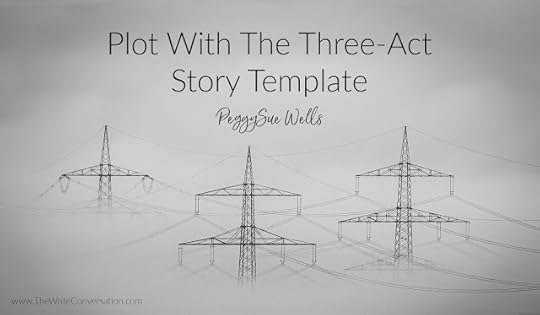Plot With The Three-Act Story Template

by PeggySue Wells @PeggySueWells
Plot is what people do and why they do it. Within the construct of narrative fiction, plot is the main events of a story presented as an interrelated sequence. When crafting your story, sometimes having a template to help you know where to include key aspects is helpful to the full development of your plot.
One popular outline is the three-act story. In his 1979 book, Screenplay: The Foundations of Screenwriting, Syd Field outlined the three parts as Setup, Confrontation, and Resolution. In this format, your tale generally fits into three parts. The first and third sections are a quarter each to equal half of the story. The middle, or second act, is half of the story in length. The structure looks like this:
Act 1: SetupThe first fourth of the manuscript introduces the main elements. Bring in the reader with a strong hook. Occasionally, the hook presents itself early in the writing, but more often a writer returns to polish the roughly crafted first chapter, the first paragraph, and the first line once the project is complete. After all, we know a lot more about the characters and plot when we’ve reached the end.
Begin by jumping into the action as soon as possible. Explain the details behind the excitement later. In the first actintroduce the reader to important characters present the inciting incident from which our characters have no way to return. Unable to go around, over, or under, their only way is through the story.add complications and obstacles the characters we care about must face provide a crisis that sets up the second actAct 2: ConfrontationIn the middle half of the manuscript, the author will further develop the charactersprevent the character we care about from achieving their goalintensify the suspenseset up the resolution of act three with an explosive moment that has been building Act 3: ResolutionThe final fourth of the story.Expand the conflict to be the focal point. Pace the ending to feel natural and not rushed to the reader.Craft a satisfying ending that connects back to the beginning. Surprise the reader with how the details of the story come together.Tie up all the loose ends.Sketching your story into the three-act template is a proven way to provide compelling pacing. This model serves as a checklist to remind the writer to include the important ingredients of a strong plot.
TWEETABLEPlot with the Three-Act Template - tips from @PeggySueWells on @EdieMelson (Click to Tweet)
 Tropical island votary and history buff, PeggySue Wells parasails, skydives, snorkels, scuba dives, and has taken (but not passed) pilot training. Writing from the 100-Acre Wood in Indiana, Wells is the bestselling author of thirty books including The Slave Across the Street, Slavery in the Land of the Free, Bonding With Your Child Through Boundaries, Homeless for the Holidays, Chasing Sunrise, and The Ten Best Decisions A Single Mom Can Make. Founder of SingleMomCircle.com, PeggySue is named for the Buddy Holly song with the great drumbeat. At school author visits, she teaches students the secrets to writing and speaks at events and conferences. Connect with her at www.PeggySueWells.com, on Facebook at PeggySue Wells, and LinkedIn at linkedin.com/in/peggysuewells
Tropical island votary and history buff, PeggySue Wells parasails, skydives, snorkels, scuba dives, and has taken (but not passed) pilot training. Writing from the 100-Acre Wood in Indiana, Wells is the bestselling author of thirty books including The Slave Across the Street, Slavery in the Land of the Free, Bonding With Your Child Through Boundaries, Homeless for the Holidays, Chasing Sunrise, and The Ten Best Decisions A Single Mom Can Make. Founder of SingleMomCircle.com, PeggySue is named for the Buddy Holly song with the great drumbeat. At school author visits, she teaches students the secrets to writing and speaks at events and conferences. Connect with her at www.PeggySueWells.com, on Facebook at PeggySue Wells, and LinkedIn at linkedin.com/in/peggysuewells
Published on January 31, 2022 22:00
No comments have been added yet.



